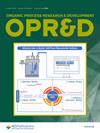Development of a 3D Printed Flow Cell for Application as an In-line Optical Particle Analysis Tool
IF 3.1
3区 化学
Q2 CHEMISTRY, APPLIED
Organic Process Research & Development
Pub Date : 2024-10-18
DOI:10.1021/acs.oprd.4c0016810.1021/acs.oprd.4c00168
引用次数: 0
Abstract
The demand for a cost-effective in-line particle measurement device is high, and the image analysis of particles in flow represents a promising concept to meet these expectations. In this work, we present an in-house developed image analysis flow cell to track particle size distributions in a process stream, including the necessary code and printing files for open-source use. For benchmarking of the flow cell, premade seeded solutions were prepared and analyzed by comparing the results to already applied and commercially available particle measurement devices. Furthermore, the results of six mixed-suspension, mixed-product-removal crystallization experiments were evaluated with the new measurement system.
开发可用作在线光学粒子分析工具的 3D 打印流动池
人们对具有成本效益的在线颗粒测量设备的需求很高,而对流动中的颗粒进行图像分析则是满足这些期望的一个很有前途的概念。在这项工作中,我们介绍了一种内部开发的图像分析流动池,用于跟踪工艺流中的粒度分布,包括必要的代码和打印文件,供开源使用。为了对流动池进行基准测试,我们制备了预制的种子溶液,并将结果与已应用的商用颗粒测量设备进行了比较分析。此外,还利用新测量系统对六次混合悬浮、混合产品去除结晶实验的结果进行了评估。
本文章由计算机程序翻译,如有差异,请以英文原文为准。
求助全文
约1分钟内获得全文
求助全文
来源期刊
CiteScore
6.90
自引率
14.70%
发文量
251
审稿时长
2 months
期刊介绍:
The journal Organic Process Research & Development serves as a communication tool between industrial chemists and chemists working in universities and research institutes. As such, it reports original work from the broad field of industrial process chemistry but also presents academic results that are relevant, or potentially relevant, to industrial applications. Process chemistry is the science that enables the safe, environmentally benign and ultimately economical manufacturing of organic compounds that are required in larger amounts to help address the needs of society. Consequently, the Journal encompasses every aspect of organic chemistry, including all aspects of catalysis, synthetic methodology development and synthetic strategy exploration, but also includes aspects from analytical and solid-state chemistry and chemical engineering, such as work-up tools,process safety, or flow-chemistry. The goal of development and optimization of chemical reactions and processes is their transfer to a larger scale; original work describing such studies and the actual implementation on scale is highly relevant to the journal. However, studies on new developments from either industry, research institutes or academia that have not yet been demonstrated on scale, but where an industrial utility can be expected and where the study has addressed important prerequisites for a scale-up and has given confidence into the reliability and practicality of the chemistry, also serve the mission of OPR&D as a communication tool between the different contributors to the field.

 求助内容:
求助内容: 应助结果提醒方式:
应助结果提醒方式:


